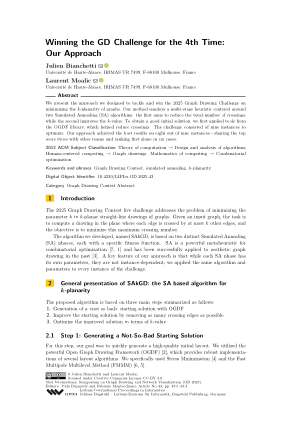Winning the GD Challenge for the 4th Time: Our Approach (Graph Drawing Contest Abstract)
Authors
Julien Bianchetti  ,
Laurent Moalic
,
Laurent Moalic 
-
Part of:
Volume:
33rd International Symposium on Graph Drawing and Network Visualization (GD 2025)
Part of: Series: Leibniz International Proceedings in Informatics (LIPIcs)
Part of: Conference: Graph Drawing and Network Visualization (GD) - License:
 Creative Commons Attribution 4.0 International license
Creative Commons Attribution 4.0 International license
- Publication Date: 2025-11-26
File

PDF
LIPIcs.GD.2025.43.pdf
- Filesize: 0.5 MB
- 4 pages
Document Identifiers
Subject Classification
ACM Subject Classification
- Theory of computation → Design and analysis of algorithms
- Human-centered computing → Graph drawings
- Mathematics of computing → Combinatorial optimization
Keywords
- Graph Drawing Contest
- simulated annealing
- k-planarity
Metrics
- Access Statistics
-
Total Accesses (updated on a weekly basis)
0PDF Downloads0Metadata Views
Abstract
We present the approach we designed to tackle and win the 2025 Graph Drawing Challenge on minimizing the k-planarity of graphs. Our method employs a multi-stage heuristic centered around two Simulated Annealing (SA) algorithms: the first aims to reduce the total number of crossings, while the second improves the k-value. To obtain a good initial solution, we first applied tools from the OGDF library, which helped reduce crossings. The challenge consisted of nine instances to optimize. Our approach achieved the best results on eight out of nine instances - sharing the top score twice with other teams and ranking first alone in six cases.
Cite As Get BibTex
Julien Bianchetti and Laurent Moalic. Winning the GD Challenge for the 4th Time: Our Approach (Graph Drawing Contest Abstract). In 33rd International Symposium on Graph Drawing and Network Visualization (GD 2025). Leibniz International Proceedings in Informatics (LIPIcs), Volume 357, pp. 43:1-43:4, Schloss Dagstuhl – Leibniz-Zentrum für Informatik (2025)
https://doi.org/10.4230/LIPIcs.GD.2025.43
BibTex
@InProceedings{bianchetti_et_al:LIPIcs.GD.2025.43,
author = {Bianchetti, Julien and Moalic, Laurent},
title = {{Winning the GD Challenge for the 4th Time: Our Approach}},
booktitle = {33rd International Symposium on Graph Drawing and Network Visualization (GD 2025)},
pages = {43:1--43:4},
series = {Leibniz International Proceedings in Informatics (LIPIcs)},
ISBN = {978-3-95977-403-1},
ISSN = {1868-8969},
year = {2025},
volume = {357},
editor = {Dujmovi\'{c}, Vida and Montecchiani, Fabrizio},
publisher = {Schloss Dagstuhl -- Leibniz-Zentrum f{\"u}r Informatik},
address = {Dagstuhl, Germany},
URL = {https://drops.dagstuhl.de/entities/document/10.4230/LIPIcs.GD.2025.43},
URN = {urn:nbn:de:0030-drops-250293},
doi = {10.4230/LIPIcs.GD.2025.43},
annote = {Keywords: Graph Drawing Contest, simulated annealing, k-planarity}
}
Author Details
References
- Dimitris Bertsimas and John Tsitsiklis. Simulated Annealing. Statistical Science, 8(1):10-15, 1993. URL: https://doi.org/10.1214/ss/1177011077.
-
Markus Chimani, Carsten Gutwenger, Michael Jünger, Gunnar W. Klau, Karsten Klein, and Petra Mutzel. The open graph drawing framework (ogdf). Chapter 17 in: R. Tamassia (ed.), Handbook of Graph Drawing and Visualization, CRC Press., 2014.

- Ron Davidson and David Harel. Drawing graphs nicely using simulated annealing. ACM Trans. Graph., 15(4):301-331, October 1996. URL: https://doi.org/10.1145/234535.234538.
- Emden Gansner, Yehuda Koren, and Stephen North. Graph drawing by stress majorization. In Graph Drawing, volume 3383, pages 239-250, September 2004. URL: https://doi.org/10.1007/978-3-540-31843-9_25.
-
Martin Gronemann. Engineering the Fast-Multipole-Multilevel method for Multicore and SIMD architectures. Master’s thesis, Technische Universität Dortmund, Dortmund, Germany, 2009.

- Stefan Hachul and Michael Jünger. Drawing large graphs with a potential-field-based multilevel algorithm. In Graph Drawing, volume 3383, pages 294-305, September 2004. URL: https://doi.org/10.1007/978-3-540-31843-9_29.
- S. Kirkpatrick, C. D. Gelatt, and M. P. Vecchi. Optimization by simulated annealing. Science, 220(4598):671-680, 1983. URL: https://doi.org/10.1126/science.220.4598.671.
